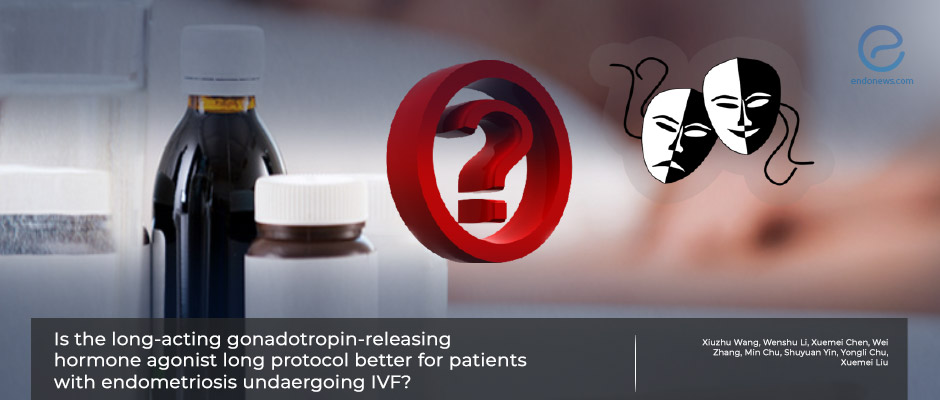Comparison of different IVF stimulation protocols for pregnancy success in infertile endometriosis patients
Mar 8, 2023
The long-acting GnRH agonist long protocol as stimulation protocol during IVF treatment in endometriosis patients increases clinical pregnancy and live birth rates.
Key Points
Highlights:
- Pituitary suppression for a long time using GnRH agonists in infertile women with endometriosis increases the success of IVF treatment.
Importance:
- Compared to the short-acting GnRH agonist long protocol and the GnRH antagonist protocol, the long-acting GnRH agonist long protocol provides higher live birth rates in women having infertility due to endometriosis.
What’s done here?
- Infertile women, aged 20-40 years who underwent the first IVF cycle were included in this retrospective cohort study.
- Participants were diagnosed with endometriosis laparoscopically and confirmed with histopathological examination.
- The population was analyzed in 3 groups based on ovarian stimulation: (Group 1) the long-acting gonadotropin-releasing hormone agonist (GnRHa) long protocol in the follicular phase, (Group 2) the short-acting GnRHa long protocol in the mid-luteal phase and (Group 3) the GnRH antagonist protocol.
- The clinical pregnancy rate (an intrauterine gestational sac visualized on ultrasound, was the primary outcome
- Secondary outcomes included the implantation rate, live birth rate, high-quality embryo rate, blastocyst formation rate, endometrial thickness on the day of the human chorionic gonadotropin (hCG) injection, serum LH level on gonadotropin initiation and hCG day, serum E2 on gonadotropin initiation.
Key results:
- A total of 798 patients were enrolled: 204 patients in Group 1 (the long-acting GnRHa long protocol in the follicular phase), 326 patients in Group 2 (the short-acting GnRHa long protocol in the mid-luteal phase), and 268 patients in Group 3 (receiving GnRH antagonist).
- Women were comparable in terms of age, duration of infertility, body mass index, serum anti-Müllerian hormone (AMH) level, previous pregnancy history, and infertility diagnosis.
- The duration of stimulation, amount of gonadotropin, and the number of high-quality embryos transferred were found to be significantly higher in the long-acting GnRHa long protocol group compared to the other two groups.
- After adjustment of all potential confounding factors, the clinical pregnancy and implantation rates of patients in Group 1 were significantly higher than those of patients in Groups 2 and 3.
- In addition, the live birth rate was significantly higher in Group 1 compared to Group 3 whereas there was no significant difference between Group 1 and Group 2 regarding the live birth rate.
Limitations
- Retrospective design, the inability to control all potential confounders on live birth rate, and being a single-center study could be accepted as the limitations.
Lay Summary
Women with endometriosis may suffer from reproductive problems up to an incidence of 50%.
Several pathophysiological mechanisms including anatomic distortion, alterations in endometrial receptivity, diminished tubal peristalsis and sperm movements are the most responsible for the development of endometriosis-associated infertility. Assisted reproduction technology (ART) is the most frequently preferred treatment approach in infertile women with endometriosis. There are different protocols for ovarian stimulation during in vitro fertilization (IVF) treatment.
Wang et al, from China, published a study titled “Is the long-acting gonadotropin-releasing hormone agonist long protocol better for patients with endometriosis undergoing IVF?” in the journal named "International Journal of Gynecology and Obstetrics". The authors aimed to assess the pregnancy outcomes in terms of clinical pregnancy and live birth compared with different ovarian stimulation protocols (Group 1: the long-acting GnRHa long protocol in the follicular phase, Group 2: the short-acting GnRHa long protocol in the mid-luteal phase and Group 3: the GnRH antagonist protocol).
All participants had laparoscopically confirmed endometriosis and underwent the first IVF cycle.
There was no significant difference regarding the type of fertilization, high-quality embryo rate, blastocyst formation rate, and incidence of ovarian hyperstimulation syndrome (OHSS) between the groups. The duration of stimulation, amount of gonadotropin, and the number of high-quality embryos transferred were found to be significantly higher in the long-acting GnRHa long protocol group compared to the other two groups.
The clinical pregnancy and implantation rates of patients in Group 1 were significantly higher than those of patients in Groups 2 and 3. The live birth rate was also significantly higher in Group 1 compared with Group 3, whereas there was no significant difference between Group 1 and Group 2 regarding the live birth rate.
“The long-acting GnRHa long protocol could improve IVF outcomes of patients with EMs compared with the short-acting GnRHa long protocol and the GnRH antagonist protocol.” the authors added.
Research Source: https://pubmed.ncbi.nlm.nih.gov/36688363/
endometriosis infertility live birth rate clinical pregnancy rate long-acting GnRHa GnRH antagonist assisted reproduction technology in vitro fertilization

